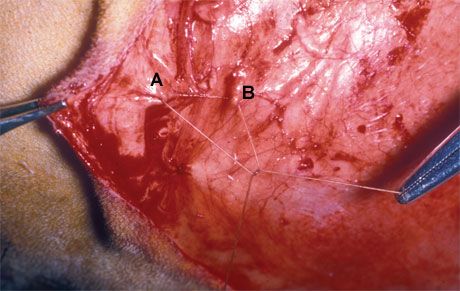Walking sutures: Step 3A
(click photo for larger view) <Step 2 | Step 3B>Step by Step Article








IntroductionStep 1Step 2Step 3AStep 3BStep 3CStep 3DStep 3E Using 2-0 or 3-0 absorbable suture material with a swaged needle, place the first walking suture near the junction of the undermined skin and the underlying tissue. Pass the first suture bite through the deep portion of the dermis but not through the full-thickness of the skin (A in photo above and schematic in Step 3B). Pass the needle perpendicular to the wound edge to help conserve blood supply to the skin. By carefully observing the deep portion of the dermis in areas without a panniculus muscle, you can avoid incorporating large vessels into the suture, thus ensuring adequate blood supply to the skin. You should feel some resistance to the needle passage; this resistance indicates proper placement in the dermis. Before completely passing the needle through the partial thickness of the dermis, place some tension on the needle. A dimple should form on the epidermis, further indicating that the needle is properly placed. Then complete the needle passage.
Take the second suture bite toward the center of the wound (B in photo above and schematic in Step 3B). To ascertain precisely where to take the second bite, pinch the area of the first bite between your thumb and forefinger, with your thumb on the dermal skin surface and your forefinger on the epidermal surface. Stretch the skin toward the center of the wound as far as possible, and place the first suture bite down against the underlying tissue. Take the second suture bite at this point, incorporating the dense muscle fascia. If the bite is being placed in granulation tissue with secondary wound closure, place it deeply so it can pass through the dense collagenous base of this tissue.



Video
Step 4A

Step 4B






